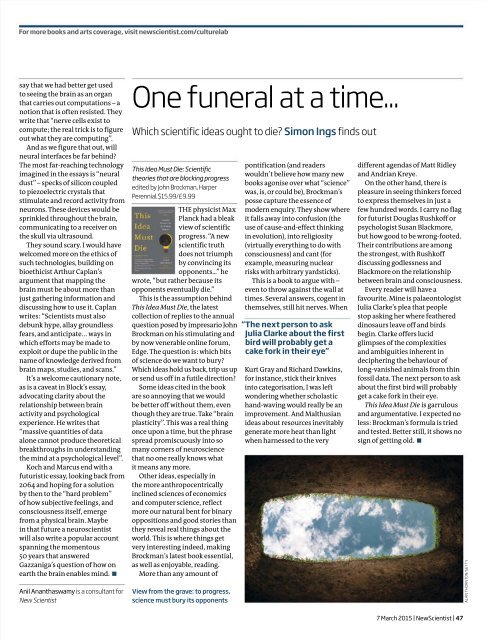New Scientist Magazine - No. 3011
New Scientist Magazine - No. 3011
New Scientist Magazine - No. 3011
You also want an ePaper? Increase the reach of your titles
YUMPU automatically turns print PDFs into web optimized ePapers that Google loves.
For more books and arts coverage, visit newscientist.com/culturelabsay that we had better get usedto seeing the brain as an organthat carries out computations – anotion that is often resisted. Theywrite that “nerve cells exist tocompute; the real trick is to figureout what they are computing”.And as we figure that out, willneural interfaces be far behind?The most far-reaching technologyimagined in the essays is “neuraldust” – specks of silicon coupledto piezoelectric crystals thatstimulate and record activity fromneurons. These devices would besprinkled throughout the brain,communicating to a receiver onthe skull via ultrasound.They sound scary. I would havewelcomed more on the ethics ofsuch technologies, building onbioethicist Arthur Caplan’sargument that mapping thebrain must be about more thanjust gathering information anddiscussing how to use it. Caplanwrites: “<strong>Scientist</strong>s must alsodebunk hype, allay groundlessfears, and anticipate… ways inwhich efforts may be made toexploit or dupe the public in thename of knowledge derived frombrain maps, studies, and scans.”It’s a welcome cautionary note,as is a caveat in Block’s essay,advocating clarity about therelationship between brainactivity and psychologicalexperience. He writes that“massive quantities of dataalone cannot produce theoreticalbreakthroughs in understandingthe mind at a psychological level”.Koch and Marcus end with afuturistic essay, looking back from2064 and hoping for a solutionby then to the “hard problem”of how subjective feelings, andconsciousness itself, emergefrom a physical brain. Maybein that future a neuroscientistwill also write a popular accountspanning the momentous50 years that answeredGazzaniga’s question of how onearth the brain enables mind. ■Anil Ananthaswamy is a consultant for<strong>New</strong> <strong>Scientist</strong>One funeral at a time...Which scientific ideas ought to die? Simon Ings finds outThis Idea Must Die: Scientifictheories that are blocking progressedited by John Brockman, HarperPerennial, $15.99/£9.99THE physicist MaxPlanck had a bleakview of scientificprogress. “A newscientific truthdoes not triumphby convincing itsopponents...” hewrote, “but rather because itsopponents eventually die.”This is the assumption behindThis Idea Must Die, the latestcollection of replies to the annualquestion posed by impresario JohnBrockman on his stimulating andby now venerable online forum,Edge. The question is: which bitsof science do we want to bury?Which ideas hold us back, trip us upor send us off in a futile direction?Some ideas cited in the bookare so annoying that we wouldbe better off without them, eventhough they are true. Take “brainplasticity”. This was a real thingonce upon a time, but the phrasespread promiscuously into somany corners of neurosciencethat no one really knows whatit means any more.Other ideas, especially inthe more anthropocentricallyinclined sciences of economicsand computer science, reflectmore our natural bent for binaryoppositions and good stories thanthey reveal real things about theworld. This is where things getvery interesting indeed, makingBrockman’s latest book essential,as well as enjoyable, reading.More than any amount ofView from the grave: to progress,science must bury its opponentspontification (and readerswouldn’t believe how many newbooks agonise over what “science”was, is, or could be), Brockman’sposse capture the essence ofmodern enquiry. They show whereit falls away into confusion (theuse of cause-and-effect thinkingin evolution), into religiosity(virtually everything to do withconsciousness) and cant (forexample, measuring nuclearrisks with arbitrary yardsticks).This is a book to argue with –even to throw against the wall attimes. Several answers, cogent inthemselves, still hit nerves. When“ The next person to askJulia Clarke about the firstbird will probably get acake fork in their eye”Kurt Gray and Richard Dawkins,for instance, stick their knivesinto categorisation, I was leftwondering whether scholastichand-waving would really be animprovement. And Malthusianideas about resources inevitablygenerate more heat than lightwhen harnessed to the verydifferent agendas of Matt Ridleyand Andrian Kreye.On the other hand, there ispleasure in seeing thinkers forcedto express themselves in just afew hundred words. I carry no flagfor futurist Douglas Rushkoff orpsychologist Susan Blackmore,but how good to be wrong-footed.Their contributions are amongthe strongest, with Rushkoffdiscussing godlessness andBlackmore on the relationshipbetween brain and consciousness.Every reader will have afavourite. Mine is palaeontologistJulia Clarke’s plea that peoplestop asking her where feathereddinosaurs leave off and birdsbegin. Clarke offers lucidglimpses of the complexitiesand ambiguities inherent indeciphering the behaviour oflong-vanished animals from thinfossil data. The next person to askabout the first bird will probablyget a cake fork in their eye.This Idea Must Die is garrulousand argumentative. I expected noless: Brockman’s formula is triedand tested. Better still, it shows nosign of getting old. ■ALAN THORNTON/GETTY7 March 2015 | <strong>New</strong><strong>Scientist</strong> | 47


